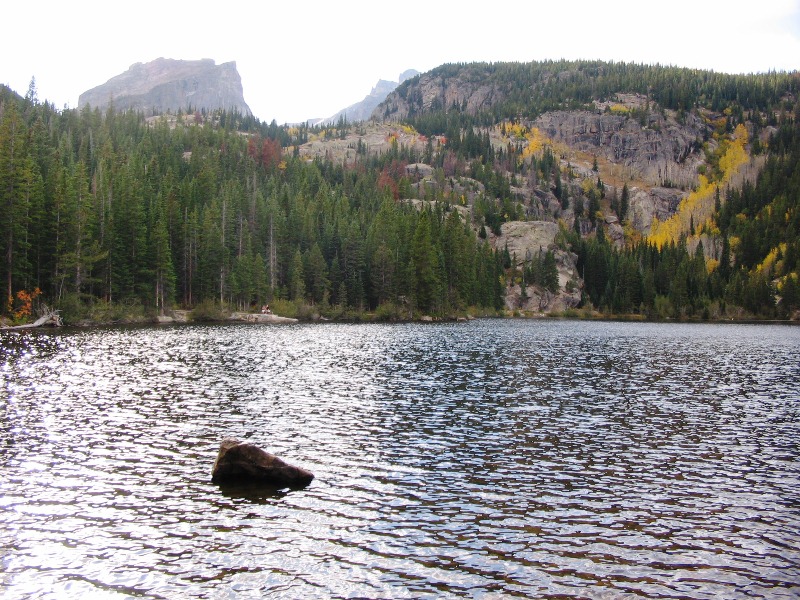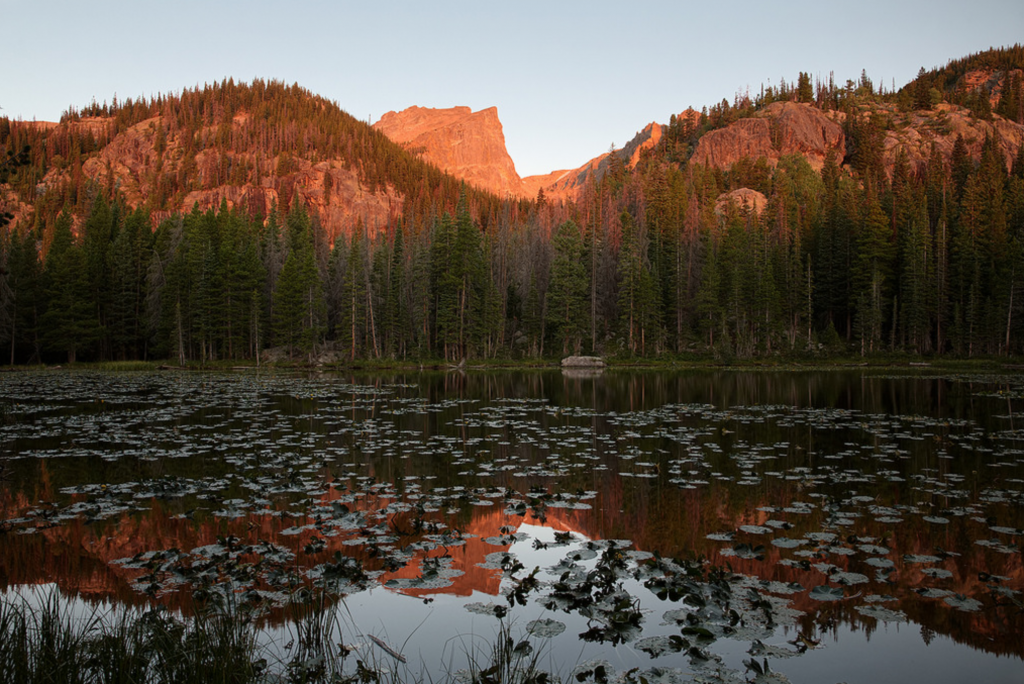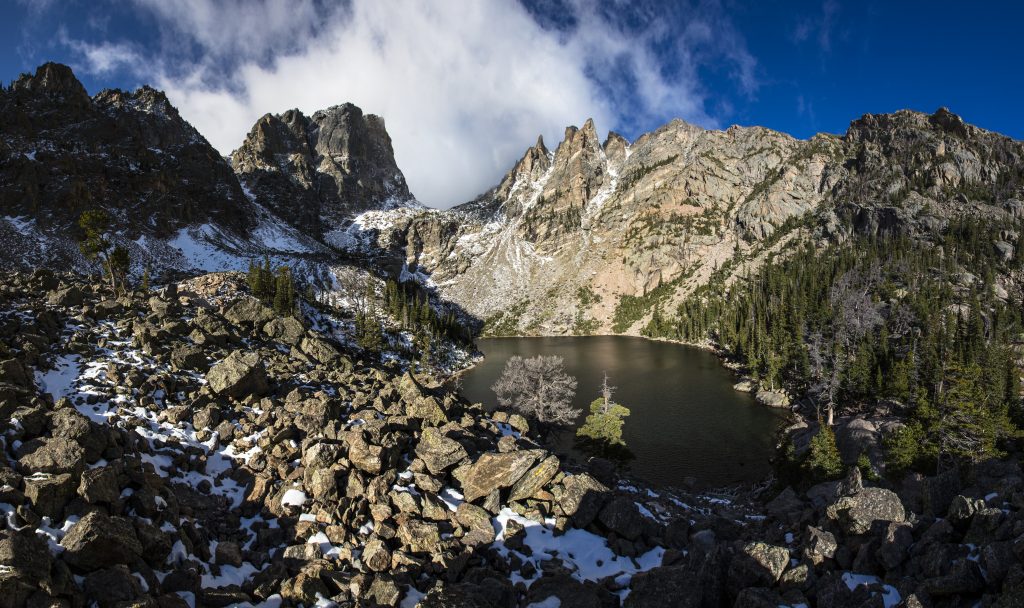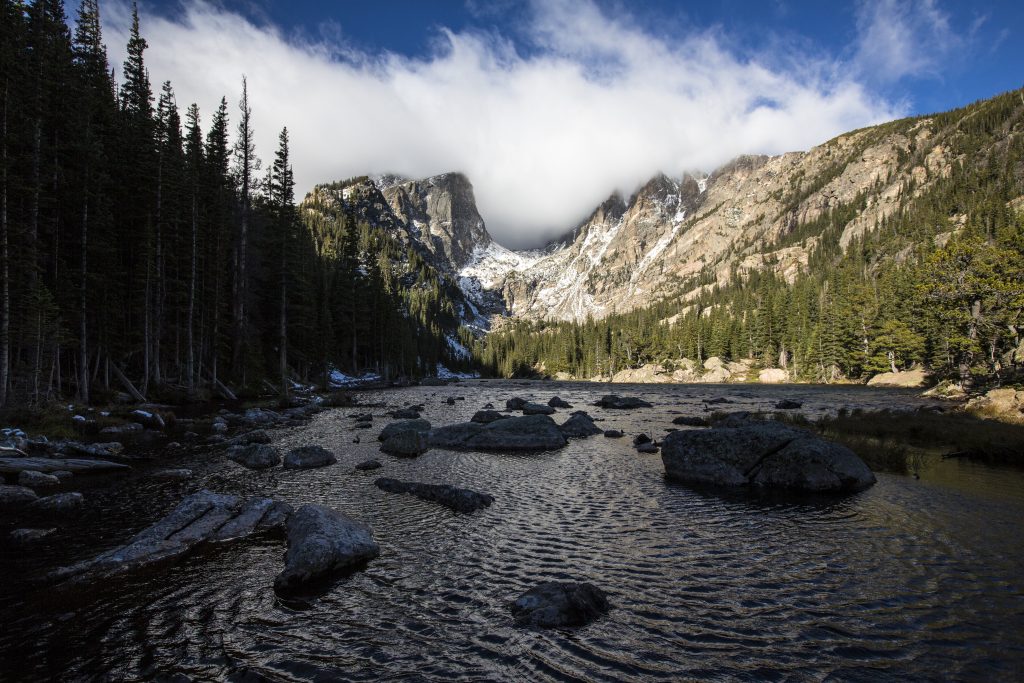
Park’s lakes offer beauty, hiking trails
ESTES PARK, Colo. – About 28,000 years ago, after the last ice age, Rocky Mountain National Park’s famous lakes were formed. There are now 21 lakes and among those lakes are the park’s most famous, including Bear Lake, Nymph Lake, Dream Lake, and Emerald Lake. These lakes offer a trail system that is one of the most popular hiking trails in the park.
Kyle Patterson, management specialist and public affairs officer at Rocky Mountain National Park, said that these lakes offer hiking trails for visitors of all ages to partake.
“It has both beautiful scenery and a hiker can choose any distance from a few hundred yards to over three miles,” Patterson said. “Almost anyone can have a great hiking experience.”
 |
Bear Lake is a popular location for visitors to Rocky Mountain National Park (Photo courtesy of the National Park Service.) |
Patterson added that ” the trail starts at Bear Lake and goes first to Nymph Lake, then to Dream Lake and finally to Emerald Lake. It is one-half mile from Bear Lake to Nymph Lake, six-tenths of a mile from Nymph Lake to Dream Lake and seven-tenths of a mile from Dream Lake to Emerald Lake.”
The Bear Lake Loop, specifically, is less than one mile long and is located at the end of Bear Lake Road, nine miles from Highway 36. Bear Lake is 10 acres in size an and is at an elevation of 9,475 feet.
Jeremy Wilcox, a first-time Colorado visitor from Brooklyn, N.Y., vividly shares his experience in hiking the lake.
“Bear Lake is small but very beautiful. The trail that runs around its parameter is an easy hike for most ages,” Wilcox said. “The colors right now are gorgeous and the weather is just perfect, sunny and crisp.”
Mid-September is the epitome of fall in Estes Park, so Rocky Mountain National Park visitors frequent the park most at this time of year.
Geoff Whitby, a returning Colorado visitor from St. Helens, Merseyside, U.K., said that Bear Lake was among his favorites, especially during this time of year.
“Bear Lake is a short-level hike with the best views in my opinion,” Whitby said. “The slab-shape mountain behind the lake is currently filled with autumn colors.”
During the hike at Bear Lake, visitors can distinctly see spruce, fir, lodgepole pine, aspen and lots and lots of visitors if one does not come early enough.
Maria Edible, a resident of Denver, said that while it is an easy hike, there is one tip that she would suggest to future park visitors.
“Come as early as possible. There are fewer crowds and more wildlife. It’s quite beautiful but very popular and crowded,” Edible said. “It’s an overall very easy, flat hike and great for families or elderly people. There is even a wheelchair ramp in one area.”
| Nymph Lake (Photo courtesy of John Wright). |  |
Nymph Lake branches left from the Bear Lake Loop and is less than four miles in length, about two acres in size, and is at an elevation of 9,700 feet. The lake is mostly a flat climb from Bear Lake and is filled with pond lilies. The area is an ideal location to watch a sunrise or for a family picnic.
Dream and Emerald lakes were the most favorite among park visitors.
Mark Burns, a frequent Colorado visitor and resident of Oshkosh, Wis., said that he enjoys hiking to Emerald and Dream lakes the most.
“The entire area surrounding Dream and Emerald Lake is simply gorgeous,” Burns said. “I like watching the brook trout in the clear waters of both lakes.”
| Emerald Lake (Photo courtesy of the National Park Service). |  |
Wilcox added that Dream Lake was his favorite in the trail system.
“As we neared Dream Lake, the views were stunning. There were panoramic views of the Rockies and lots of babbling brooks,” Wilcox said. “Dream Lake itself was a postcard quality spot. Beautiful clear water and beautiful mountains behind it. Lots of rocks and spots to sit and enjoy the view.”
Dream Lake, which branches to the left from the Bear Lake Loop and past Nymph and Lake Haiyaha, another scenic lake at Rocky Mountain National Park, is less than three miles, three acres in size and is at an elevation of 9,900 feet. Emerald Lake, which is slightly further than Dream Lake, requires climbing a series of steps, is an overall 3.5-mile hike and is at an elevation of 10,110 feet.
Once at the lake, the Hallet Park, Flattop Mountain, and the waterfall between both mountains are most noticeable.
“The trail goes through a gorge, named Tyndall Gorge, between Hallet Peak and Flattop Mountain,” Patterson said. “Drainage from Tyndall Glacier at the top of Tyndall Gorge flows into and through Emerald Lake, then to and through Dream Lake, then to and through Nymph Lake into Glacier Creek which flows into the Big Thompson River.”
Jordan Link, a first-time Colorado visitor from Ellicott City, Md., said that Dream Lake left her in awe.
 |
Dream Lake (Photo courtesy of the National Park Service). |
“The lake has a forest of evergreen trees with sunlight shining through. There was a clear, running under a short, wooden bridge, and for a moment, it was like we had entered another world,” Link said enthusiastically. “My sister and I called the area ‘The Shire’ because of the clear stream, the little bridge, and the tall green trees surrounding us. The lake is deserving of its name.”
For fishing enthusiasts, only one of these four lakes is known to contain fish.
“Bear Lake, Nymph Lake, and Emerald Lake are thought to be fishless,” Patterson said. “But Dream Lake is a popular fishing spot.”
Rocky Mountain National Park is home to a myriad of scenic lakes and as for how they are maintained, Patterson added that “the park does not generally do anything to maintain the lakes. In most cases, we let nature take its course.”
If You Go
- Weather permitting, the park is open 24 hours a day, all year round.
- Take lots of water and light snacks, as hikes to Emerald and Dreams lakes can be lengthy.
- Make sure to use a park map to get around. Keep up with road status alerts for unexpected closures.
- It is best to hike to the lakes early or late in the day, as they tend to become crowded (especially Bear Lake) and parking lots fill up quickly.
- The park has more visitors the summer and fall, but no worries, there is a free shuttle bus service available during these seasons.
- There are seven visitor centers where visitors can engage in educational activities, such as joining a ranger for a program, watching park movies, viewing exhibits or to just simply ask questions.
- A list of the visitor centers, their addresses and hours of operation can be found at https://www.nps.gov/romo/planyourvisit/visitorcenters.htm.

Comments are Closed